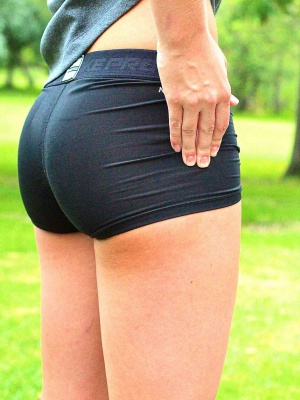Gluteal Tendinopathy
Original Editor - Your name will be added here if you created the original content for this page.
Lead Editors
Introduction[edit | edit source]
Gluteal Tendinopathy (GT) is defined as moderate to sever disabling pain over the Greater Trochanter (lateral hip pain). It is often referred to as Greater Trochanter Pain Syndrome (GTPS) and was traditionally diagnosed as Trochanteric Bursitis, however, recent research defines non-inflammatory tendinopathy of the gluteus medius(GMed) and/or gluteus minimus (GMin) muscles to be the main source of lateral hip pain[1].
This condition affects both athletes (particularly runners) and less active people[1]. One of four females over 50 years is likely to be affected by GT[2].
Gluteal Tendinopathy (GT) has significant impacts on the quality of life, it interferes with sleep (side lying) and common weight bearing tasks[1].
Pathoanatomy/Pathomechanics[edit | edit source]
Tendon structure and loading capacity are influenced by mechanical loading which triggers physiological responses within the tendon. Under normal conditions, the tendon undergoes a cycle of balanced catabolic and anabolic processes. Changes in loading type, intensity or frequency disrupt this harmony. Eccentric contractions in outer ranges (when the muscle is active and the tendon is lengthening simultaneously) represent the greatest form of loading. Failure to adapt to loading, due to rapid increase in intensity and/or frequency with insufficient recovery time, results in a series of catabolic effects which in turn result in altering tenocyte behaviour, reducing load-bearing capacity and predisposing tendons to injury at relatively low tensile loads. A combination of both tensile loading and compression are found to be more damaging than either alone[3].
GMed and GMin tendons are subjected to compression due to several factors:
1- Joint position: the ITB presents a compressive force on gluteal tendons that magnifies as the hip moves into further adduction. Birnbaum et al. [4] reported a change from 4 to 106 N ITB compression as the angle of hip adduction increased from 0 to 40 degrees. Adopting a constant or a repetitive hip adduction during static and dynamic tasks possibly contribute to the development of GT.
Examples of activities and positions:
- standing with one hip in adduction
- sitting with knees together crossed in adduction
- excessive lateral pelvic tilt or shift during dynamic single leg loading tasks.
- Running with a midline or cross-midline foot-ground contact pattern
ITB tension also exert loads on GMed and GMin tendons at higher degrees of flexion through the fascial confluence of the ITB with the gluteal fascia . These findings suggest that combining adduction and flexion, such as in sitting with the knee crossed or adducted, further increases the exerted ITB tension, thus worsens the condition.
2-Muscle Force: an imbalance in controlling frontal plane movement between the trochanteric abductors (GMed and GMin) and the ITB-tensioners (upper abducting portion of gluteus maximus (UGM), tensor fascia lata (TFL) and vastus lateralis (VL) was observed in patients with GT[5][6]. Suggesting an an altered biomechanical force distribution and abnormal mechanical loading on gluteal tendons, however, further studies are needed to confirm this hypothesis.
3-Bony Factors: a biomechanical study using cadaveric modeling showed increased compressive force associated with reduced femoral neck angle[7]. Another study related the severity of GT to lower femoral neck-shaft angle compared with pain-free subjects with hip OA[8]. Lower neck-shaft angle is likely to contribute to greater offset (the difference between the width of the iliac wings and that of the greater trochanters). All these bony factors are suggested to influence ITB compression against gluteal tendons[1].
Clinical Presentation[edit | edit source]
Studies using various scales rate it as a cause of moderate to severe pain and disability [1-4], with one study demonstrating quality of life and levels of
disability to be similar to end stage hip osteoarthritis (OA)[5].
Diagnostic Procedures[edit | edit source]
add text here relating to diagnostic tests for the condition
Outcome Measures[edit | edit source]
add links to outcome measures here (see Outcome Measures Database)
Management / Interventions
[edit | edit source]
add text here relating to management approaches to the condition
Differential Diagnosis
[edit | edit source]
add text here relating to the differential diagnosis of this condition
Resources
[edit | edit source]
add appropriate resources here
References[edit | edit source]
- ↑ 1.0 1.1 1.2 1.3 Grimaldi A, Mellor R, Hodges P, Bennell K, Wajswelner H, Vicenzino B. Gluteal tendinopathy: a review of mechanisms, assessment and management. Sports Medicine. 2015 Aug 1;45(8):1107-19.
- ↑ Mellor, R., Bennell, K., Grimaldi, A., Nicolson, P., Kasza, J., Hodges, P., Wajswelner, H. and Vicenzino, B., 2018. Education plus exercise versus corticosteroid injection use versus a wait and see approach on global outcome and pain from gluteal tendinopathy: prospective, single blinded, randomised clinical trial. bmj, 361, p.k1662.
- ↑ Almekinders LC, Weinhold PS, Maffulli N. Compression etiology in tendinopathy. Clinics in sports medicine. 2003 Oct 1;22(4):703-10.
- ↑ Birnbaum K, Siebert CH, Pandorf T, Schopphoff E, Prescher A, Niethard FU. Anatomical and biomechanical investigations of the iliotibial tract. Surgical and Radiologic Anatomy. 2004 Dec 1;26(6):433-46.
- ↑ Sutter R, Kalberer F, Binkert CA, Graf N, Pfirrmann CW, Gutzeit A. Abductor tendon tears are associated with hypertrophy of the tensor fasciae latae muscle. Skeletal radiology. 2013 May 1;42(5):627-33.
- ↑ Pfirrmann CW, Notzli HP, Dora C, Hodler J, Zanetti M. Abductor tendons and muscles assessed at MR imaging after total hip arthroplasty in asymptomatic and symptomatic patients. Radiology. 2005 Jun;235(3):969-76.
- ↑ Birnbaum K, Prescher A, Niethard FU. Hip centralizing forces of the iliotibial tract within various femoral neck angles. Journal of Pediatric Orthopaedics B. 2010 Mar 1;19(2):140-9.
- ↑ Fearon AM, Stephens S, Cook JL, Smith PN, Neeman T, Cormick W, Scarvell JM. The relationship of femoral neck shaft angle and adiposity to greater trochanteric pain syndrome in women. A case control morphology and anthropometric study. Br J Sports Med. 2012 Sep 1;46(12):888-92.







